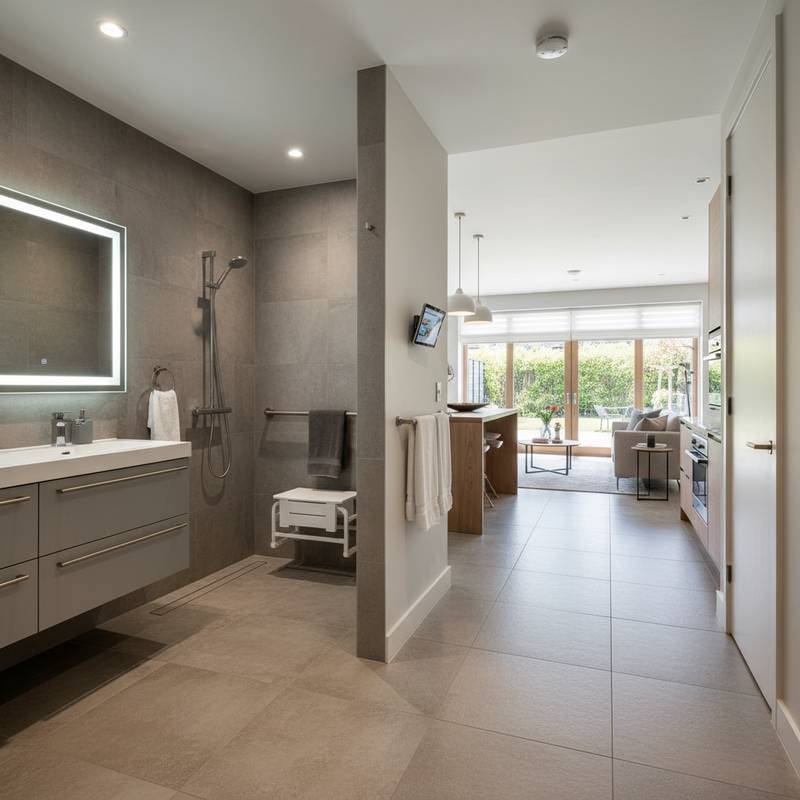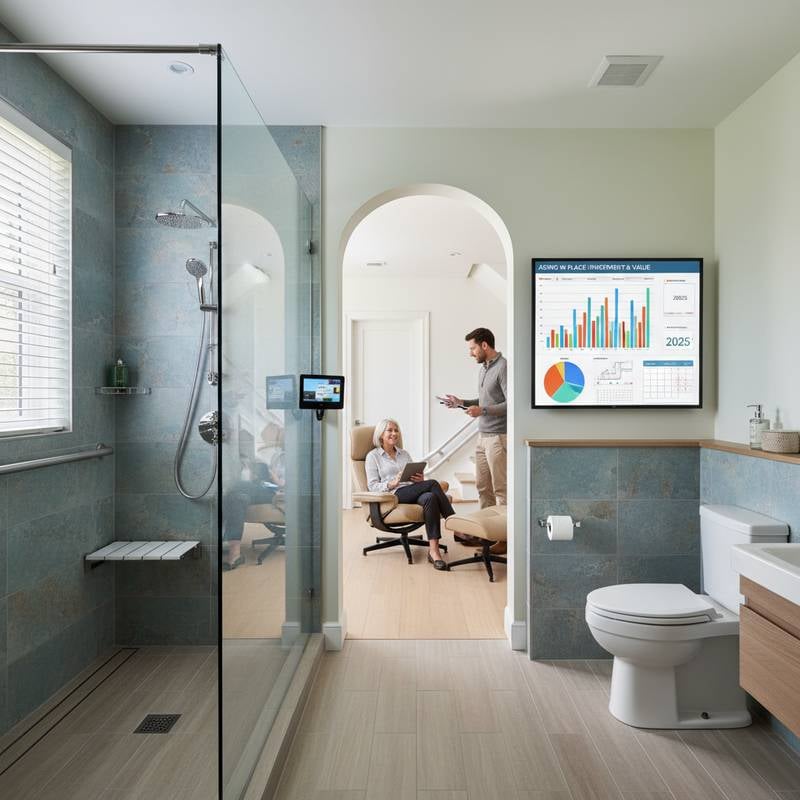2025 Costs: Universal Design for Aging in Place
Creating a home that supports comfort, safety, and independence through every stage of life represents a thoughtful investment in long-term livability. Universal design for aging in place adapts your living space to meet evolving mobility and accessibility needs without compromising style or function. By understanding potential costs and available options, you can plan a remodel that aligns with your lifestyle and budget.
What Universal Design Means for Your Home
Universal design creates spaces usable by individuals of all ages and physical abilities. The approach simplifies daily activities and enhances safety while maintaining an attractive, cohesive aesthetic. Rather than retrofitting medical-style elements later, this method incorporates accessibility features from the outset, such as wider doorways, step-free entries, lever handles, and strategically placed lighting.
These elements emphasize balance and foresight. Designs provide comfort without appearing clinical and integrate seamlessly with the home's architecture and materials. When executed effectively, universal design elevates both functionality and visual appeal.
Understanding the Cost Ranges
Costs for aging-in-place remodeling depend on project scale, material choices, and the necessity of structural modifications. You may implement universal design upgrades in phases or as part of a comprehensive renovation. The ranges below offer a baseline for expectations:
- Small updates: $500 to $5,000 for items like grab bars, lever-style handles, or non-slip flooring.
- Moderate remodels: $10,000 to $50,000 for accessible bathrooms, widened doorways, and enhanced lighting.
- Major renovations: $50,000 to $150,000 for full redesigns encompassing kitchens, entryways, and multi-level solutions like lifts or ramps.
Variations arise from finishes, local labor rates, and the home's current configuration. Engaging a certified aging-in-place specialist assists in prioritizing elements that suit your financial parameters.
Key Universal Design Features and Their Costs
The following outlines essential upgrades that boost accessibility and comfort, fostering sustained independence.
1. Step-Free Entry and Accessible Pathways
A no-step entry enhances safety and ease for all occupants. This upgrade might require regrading walkways, installing ramps, or adjusting thresholds.
Why it works: It eliminates tripping risks and facilitates wheelchair or walker navigation.
Cost range: $2,000 to $10,000, influenced by materials and site conditions.
Pairing idea: Match the ramp surface to your home's exterior stone or siding for visual harmony.
2. Wider Doorways and Hallways
Standard doorways often prove restrictive for mobility aids. Widening them to a minimum of 36 inches promotes fluid movement across the residence.
Why it works: It fosters an open layout and removes physical obstacles.
Cost range: $500 to $2,500 per doorway.
Pairing idea: Apply uniform trim colors to ensure smooth, connected transitions.
3. Accessible Bathrooms
Bathrooms demand priority in universal design enhancements. Incorporate curbless showers, grab bars, adjustable showerheads, and comfort-height toilets to promote safety and self-reliance.
Why it works: These elements support intuitive use while preserving elegance.
Cost range: $15,000 to $40,000 for a complete overhaul.
Pairing idea: Select matte finishes for fixtures to minimize glare and align tile selections for a seamless appearance.
4. Kitchen Modifications
An accessible kitchen merges practicality with adaptability. Install lowered counters, pull-out shelves, and under-counter appliances to accommodate cooking from seated or standing positions.
Why it works: It optimizes reach and operational efficiency for diverse users.
Cost range: $20,000 to $60,000, based on layout adjustments and cabinetry enhancements.
Pairing idea: Opt for light-toned cabinets to amplify natural light and cultivate an expansive atmosphere.
5. Non-Slip Flooring
Opt for smooth, glare-free, slip-resistant surfaces to bolster stability and mobility. Suitable materials include vinyl, cork, and textured tile.
Why it works: Such flooring mitigates fall risks and simplifies maintenance.
Cost range: $3 to $10 per square foot, including installation.
Pairing idea: Maintain consistent flooring across rooms to avoid uneven transitions that impede movement.
6. Improved Lighting and Controls
Strategic lighting diminishes eye strain and aids secure navigation. Layer ambient, task, and accent illumination for comprehensive coverage.
Why it works: It heightens visibility and overall ease.
Cost range: $1,000 to $5,000, varying by fixture selections and control mechanisms.
Pairing idea: Incorporate motion sensors or rocker switches for effortless operation.
7. Smart Home Integration
Smart technologies amplify autonomy. Voice-activated systems for lighting, thermostats, and security minimize physical interactions.
Why it works: They streamline routines and provide reassurance.
Cost range: $2,000 to $10,000, scaled to system complexity.
Pairing idea: Blend tech components with organic materials to preserve warmth and avoid a stark impression.
Cost Factors to Consider
Multiple elements shape the expense of a universal design remodel:
- Home age and layout: Vintage properties frequently require preliminary electrical or structural revisions.
- Material selections: Premium finishes or bespoke cabinetry elevate expenses, whereas standard options remain economical.
- Labor and expertise: Collaborate with accessibility-savvy contractors to guarantee compliant, effective designs.
- Scope of work: Phased implementation permits focusing on critical safety aspects initially, deferring cosmetic refinements.
Develop a comprehensive budget in advance to avert unforeseen expenditures. Professional assessments encompass demolition, installation, permits, and completion costs.
Style and Comfort Considerations
Universal design must avoid an institutional feel. Achieve superior outcomes through deliberate coordination of materials, textures, and hues that complement your home's essence. Consider these strategies:
- Employ neutral palettes such as Warm Greige or Soft Taupe to foster serene, versatile environments.
- Introduce contrasting trim or tile borders to delineate zones without excess visual noise.
- Specify rounded edges on counters and fixtures for security and contemporary flair.
- Combine matte and satin finishes to add dimension and regulate illumination.
These refinements render the space inviting while fulfilling accessibility objectives. Factors like lighting warmth, surface textures, and furniture arrangements further shape perceived comfort and spaciousness.
When to Hire a Professional
Certain modifications, including grab bar installation or faucet handle swaps, suit DIY efforts. However, extensive projects involving plumbing, electrical systems, or structural alterations necessitate expert involvement. A certified aging-in-place specialist assesses your environment and recommends integrations that harmonize with current aesthetics.
Experienced remodelers prioritize safety and style. They manage permits, procure appropriate materials, and adhere to schedules.
Common Questions
How do I choose which features to start with?
Prioritize safety. Target bathrooms, entryways, and flooring before advancing to aesthetic or convenience enhancements.
Does accessibility reduce home resale value?
No. Thoughtfully implemented accessible elements, using high-quality materials, broaden market appeal by accommodating diverse buyers.
Can universal design be added to any home style?
Yes. Adaptations suit traditional, contemporary, or transitional architectures through tailored finishes and details.
Steps to Implement Your Plan
Universal design for aging in place invests in autonomy, ease, and security. Initiate by evaluating home areas needing improved pathways, illumination, or entry access. Select features that align with your priorities and engage professionals for precise execution. Your residence will sustain functionality and beauty across decades.











